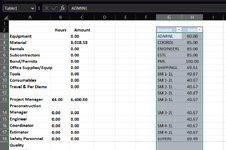ssmith3156
New Member
- Joined
- Apr 11, 2023
- Messages
- 15
- Office Version
- 365
- Platform
- Windows
I have this VLOOKUP for Table3, =IFERROR(VLOOKUP([@Concatenate],'COST TYPE SUMMARY'!$G$2:$H$35,2,FALSE),"0.00"). The rows will vary each month, so I need the formula to auto-populate the new cells when they are added. Is there a way to modify this formula to make that happen?







